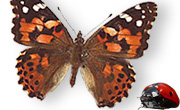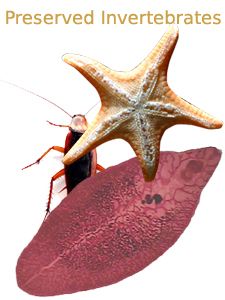Fax: (916) 381-4006



Preserved Invertebrates |
 Invertebrate is a term coined by Jean-Baptiste Lamarck to describe any animal without a spinal column. It therefore includes all animals except those in the subphylum vertebrata (fish, reptiles, amphibians, birds and mammals). Invertebrate is a term coined by Jean-Baptiste Lamarck to describe any animal without a spinal column. It therefore includes all animals except those in the subphylum vertebrata (fish, reptiles, amphibians, birds and mammals).
Lamarck divided these animals into two groups, the Insecta and the Vermes, but now, they are classified into over 30 phyla, from simple organisms such as sponges and flatworms to complex animals such as arthropods and mollusks. Since invertebrates include all animals except a certain group, invertebrates form a paraphyletic group, but, despite not forming a "natural group" (that is, monophyletic), "invertebrate" is still a widely used term. Invertebrates include 97% of all animal species. All the listed phyla are invertebrates along with two of the three subphyla in Phylum Chordata: Urochordata and Cephalochordata. These two, plus all the other known invertebrates, have only one cluster of Hox genes, while the vertebrates have duplicated their original cluster more than once.
|
| Featured Items |
|---|
| Crayfish 4-in. Plain (100... |

Crayfish, sometimes called crawfish, or crawdads are freshwater crustaceans resembling small lobsters, to w... |
|
Read more »»»
$1.45 (Buy Now) |
|---|
| Fasciola (Sheep liver flu... |
|
Read more »»»
$2.70 (Buy Now) |
|---|
| Lumbricus 9 - 12-in. (10+... |

Lumbricus terrestris is a large reddish worm native to Europe, but now also widely distributed elsewhere ar... |
|
Read more »»»
$0.55 (Buy Now) |
|---|
| Sea Urchins Preserved (10... |

Echinoderms (Phylum Echinodermata, from the Greek for spiny skin) are a phylum of marine animals found at a... |
|
Read more »»»
$4.46 (Buy Now) |
|---|
9298 Elder Creek Road
Sacramento, CA 95829
(916) 386-2665
9298 Elder Creek Road
Sacramento, CA 95829
(916) 386-2665